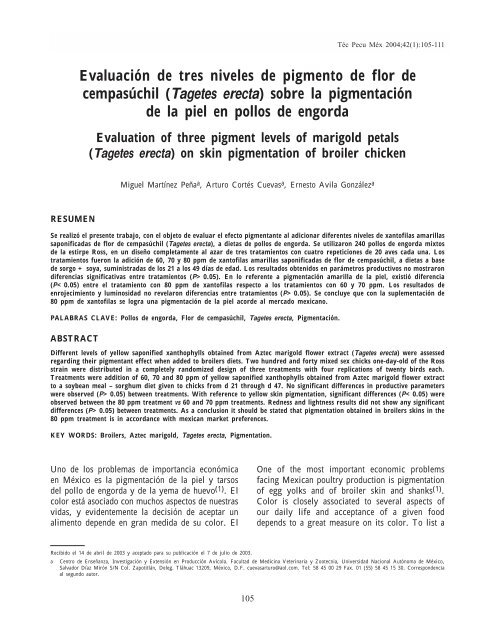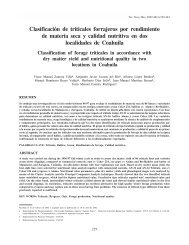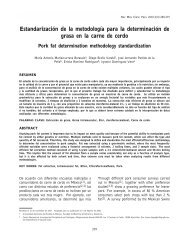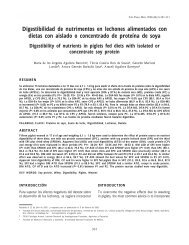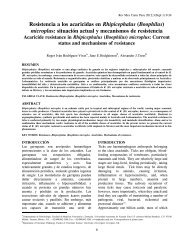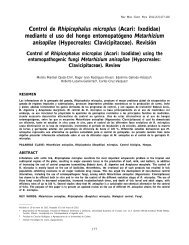Evaluación de tres niveles de pigmento de flor de cempasúchil ...
Evaluación de tres niveles de pigmento de flor de cempasúchil ...
Evaluación de tres niveles de pigmento de flor de cempasúchil ...
Create successful ePaper yourself
Turn your PDF publications into a flip-book with our unique Google optimized e-Paper software.
RESUMEN<br />
EVALUACION DE TRES NIVELES DE PIGMENTO DE FLOR DE CEMPASÚCHIL<br />
Téc Pecu Méx 2004;42(1):105-111<br />
<strong>Evaluación</strong> <strong>de</strong> <strong>tres</strong> <strong>niveles</strong> <strong>de</strong> <strong>pigmento</strong> <strong>de</strong> <strong>flor</strong> <strong>de</strong><br />
<strong>cempasúchil</strong> (Tagetes erecta) sobre la pigmentación<br />
<strong>de</strong> la piel en pollos <strong>de</strong> engorda<br />
Evaluation of three pigment levels of marigold petals<br />
(Tagetes erecta) on skin pigmentation of broiler chicken<br />
Miguel Martínez Peña a , Arturo Cortés Cuevas a , Ernesto Avila González a<br />
Se realizó el presente trabajo, con el objeto <strong>de</strong> evaluar el efecto pigmentante al adicionar diferentes <strong>niveles</strong> <strong>de</strong> xantofilas amarillas<br />
saponificadas <strong>de</strong> <strong>flor</strong> <strong>de</strong> <strong>cempasúchil</strong> (Tagetes erecta), a dietas <strong>de</strong> pollos <strong>de</strong> engorda. Se utilizaron 240 pollos <strong>de</strong> engorda mixtos<br />
<strong>de</strong> la estirpe Ross, en un diseño completamente al azar <strong>de</strong> <strong>tres</strong> tratamientos con cuatro repeticiones <strong>de</strong> 20 aves cada una. Los<br />
tratamientos fueron la adición <strong>de</strong> 60, 70 y 80 ppm <strong>de</strong> xantofilas amarillas saponificadas <strong>de</strong> <strong>flor</strong> <strong>de</strong> <strong>cempasúchil</strong>, a dietas a base<br />
<strong>de</strong> sorgo + soya, suministradas <strong>de</strong> los 21 a los 49 días <strong>de</strong> edad. Los resultados obtenidos en parámetros productivos no mostraron<br />
diferencias significativas entre tratamientos (P>0.05). En lo referente a pigmentación amarilla <strong>de</strong> la piel, existió diferencia<br />
(P0.05). Se concluye que con la suplementación <strong>de</strong><br />
80 ppm <strong>de</strong> xantofilas se logra una pigmentación <strong>de</strong> la piel acor<strong>de</strong> al mercado mexicano.<br />
PALABRAS CLAVE: Pollos <strong>de</strong> engorda, Flor <strong>de</strong> <strong>cempasúchil</strong>, Tagetes erecta, Pigmentación.<br />
ABSTRACT<br />
Different levels of yellow saponified xanthophylls obtained from Aztec marigold flower extract (Tagetes erecta) were assessed<br />
regarding their pigmentant effect when ad<strong>de</strong>d to broilers diets. Two hundred and forty mixed sex chicks one-day-old of the Ross<br />
strain were distributed in a completely randomized <strong>de</strong>sign of three treatments with four replications of twenty birds each.<br />
Treatments were addition of 60, 70 and 80 ppm of yellow saponified xanthophylls obtained from Aztec marigold flower extract<br />
to a soybean meal – sorghum diet given to chicks from d 21 through d 47. No significant differences in productive parameters<br />
were observed (P>0.05) between treatments. With reference to yellow skin pigmentation, significant differences (P0.05) between treatments. As a conclusion it should be stated that pigmentation obtained in broilers skins in the<br />
80 ppm treatment is in accordance with mexican market preferences.<br />
KEY WORDS: Broilers, Aztec marigold, Tagetes erecta, Pigmentation.<br />
Uno <strong>de</strong> los problemas <strong>de</strong> importancia económica<br />
en México es la pigmentación <strong>de</strong> la piel y tarsos<br />
<strong>de</strong>l pollo <strong>de</strong> engorda y <strong>de</strong> la yema <strong>de</strong> huevo (1) . El<br />
color está asociado con muchos aspectos <strong>de</strong> nuestras<br />
vidas, y evi<strong>de</strong>ntemente la <strong>de</strong>cisión <strong>de</strong> aceptar un<br />
alimento <strong>de</strong>pen<strong>de</strong> en gran medida <strong>de</strong> su color. El<br />
Recibido el 14 <strong>de</strong> abril <strong>de</strong> 2003 y aceptado para su publicación el 7 <strong>de</strong> julio <strong>de</strong> 2003.<br />
a Centro <strong>de</strong> Enseñanza, Investigación y Extensión en Producción Avícola. Facultad <strong>de</strong> Medicina Veterinaria y Zootecnia, Universidad Nacional Autónoma <strong>de</strong> México,<br />
Salvador Díaz Mirón S/N Col. Zapotitlán, Deleg. Tláhuac 13209, México, D.F. cuevasarturo@aol.com. Tel: 58 45 00 29 Fax. 01 (55) 58 45 15 30. Correspon<strong>de</strong>ncia<br />
al segundo autor.<br />
105<br />
One of the most important economic problems<br />
facing Mexican poultry production is pigmentation<br />
of egg yolks and of broiler skin and shanks (1) .<br />
Color is closely associated to several aspects of<br />
our daily life and acceptance of a given food<br />
<strong>de</strong>pends to a great measure on its color. To list a
catalogar un alimento como seguro, <strong>de</strong> buenas<br />
características estéticas y sensoriales, está<br />
directamente relacionado con su color (2,3) . La<br />
diferenciación <strong>de</strong>l producto, así como la relación<br />
<strong>de</strong>l color con la salud <strong>de</strong>l pollo, <strong>de</strong>finitivamente<br />
constituye una ventaja comercial, que se traduce<br />
en mejor precio <strong>de</strong> venta y preferencia por pollos<br />
que tengan la piel y los tarsos pigmentados, que<br />
aquéllos que no las tienen o presentan una coloración<br />
más clara (1) .<br />
Las principales fuentes <strong>de</strong> xantofilas empleadas por<br />
la avicultura en México son los carotenoi<strong>de</strong>s <strong>de</strong> la<br />
<strong>flor</strong> <strong>de</strong> <strong>cempasúchil</strong>, y los <strong>de</strong> chiles <strong>de</strong>l género<br />
Capsicumm (1,4) . También se utilizan <strong>pigmento</strong>s <strong>de</strong><br />
síntesis química como el apoester y la<br />
cantaxantina (5) .<br />
La <strong>flor</strong> <strong>de</strong> <strong>cempasúchil</strong> (Tagetes erecta) originaria<br />
<strong>de</strong> México es cultivada en diferentes zonas <strong>de</strong>l país<br />
(Michoacán, Sinaloa y Guanajuato) alcanzando<br />
producciones <strong>de</strong> hasta 30 t/ha (6). Las xantofilas <strong>de</strong><br />
Tagetes erecta son obtenidas por un proceso <strong>de</strong><br />
prensado, <strong>de</strong>shidratación y molienda <strong>de</strong> la <strong>flor</strong>;<br />
posteriormente se realiza una extracción (con<br />
solventes) y se obtiene una oleorresina (carotenoi<strong>de</strong>s<br />
esterificados con ácidos grasos mirístico y<br />
palmítico), dando esta mezcla un rendimiento <strong>de</strong><br />
70,000 a 120,000 ppm <strong>de</strong> xantofilas (6) . El producto<br />
obtenido es saponificado (hidrólisis alcalina; usando<br />
NaOH a 90 ºC) <strong>de</strong>jando a las xantofilas en su<br />
forma libre (1,6) . El producto terminado tiene<br />
alre<strong>de</strong>dor <strong>de</strong> 80 a 90 % <strong>de</strong> luteína, 5 % <strong>de</strong><br />
zeaxantina y <strong>de</strong> un 5 a 15 % <strong>de</strong> carotenoi<strong>de</strong>s como<br />
la violaxantina y la criptoxantina (5,7) .<br />
El nivel requerido <strong>de</strong> xantofilas en una ración para<br />
proveer una a<strong>de</strong>cuada pigmentación pue<strong>de</strong> variar<br />
ampliamente, <strong>de</strong>pendiendo <strong>de</strong> la intensidad <strong>de</strong><br />
pigmentación <strong>de</strong>seada por el mercado en<br />
particular (8) . Ávila (5) , menciona que es suficiente<br />
proporcionar <strong>de</strong> 40 a 60 ppm <strong>de</strong> xantofilas <strong>de</strong><br />
extractos <strong>de</strong> <strong>flor</strong> <strong>de</strong> <strong>cempasúchil</strong> durante las cuatro<br />
últimas semanas para una buena pigmentación<br />
amarilla en la piel. Esta coloración es evaluada<br />
empleando abanicos como el <strong>de</strong> Roche® o la<br />
colorimetría <strong>de</strong> reflectancia (7) . El primero consiste<br />
en comparar directamente mediante la observación<br />
Miguel Martínez Peña, et al. / Téc Pecu Méx 2004;42(1):105-111<br />
106<br />
certain food as healthy and safe, with a<strong>de</strong>quate<br />
aesthetic and sensorial characteristics is directly<br />
related to its color (2,3) . Product differentiation, as<br />
well as links between color and chicken health,<br />
constitute a <strong>de</strong>finite commercial advantage, which<br />
reflects in higher prices and consumer preference<br />
for those animals with pigmented shanks and<br />
skins (1) .<br />
The main xanthophyll sources used in mexican<br />
aviculture are Aztec marigold flower carotenoids,<br />
and those from chiles of the genera Capsicum (1,4) ;<br />
and also artificial pigments product of chemical<br />
synthesis as apoester and canthaxanthin (5) .<br />
Aztec marigold flower (Tagetes erecta) is grown<br />
in several areas of Mexico (Michocán, Sinaloa and<br />
Guanajuato) with productions of up to 30 t/ha.<br />
Xanthophylls are obtained from flowers through<br />
pressing, crushing and <strong>de</strong>hydration processes.<br />
Afterwards an oleoresin (ma<strong>de</strong> up by carotenoid<br />
esters of palmitic and myristic fatty acids) is obtained<br />
by extraction with solvents, which yields between<br />
70,000 and 120,000 ppm of xanthophylls (6) . This<br />
product is then saponified (alkaline hydrolysis with<br />
OHNa at 90 °C) to liberate xanthophylls (1,6) . The<br />
finished product contains 70-90 % lutein, 5 %<br />
zeaxanthin and 5-15 % of carotenoids (violaxanthin<br />
and cryptoxanthin) (5,7) .<br />
The xanthophyll amount required in a ration to<br />
obtain an a<strong>de</strong>quate pigmentation can vary wi<strong>de</strong>ly,<br />
<strong>de</strong>pending on the specific color intensity (8)<br />
<strong>de</strong>man<strong>de</strong>d by market preferences. Avila (5) mentions<br />
that 40 to 60 ppm Aztec marigold xanthophylls<br />
ad<strong>de</strong>d to diets during the last four weeks are enough<br />
to obtain an a<strong>de</strong>quate skin pigmentation. Color<br />
intensity can be assessed through fans like that of<br />
Roche® or by reflectance colorimetry (7). The first<br />
method consists of visual comparisons of a sample<br />
with a pre-established color pattern, for example,<br />
egg yolks can be compared with a 15 page color<br />
pattern numbered from 1 to 15 (8) .<br />
For broilers skins a reflectance colorimeter gra<strong>de</strong>d<br />
in the CIELAB brilliance system (L) can be used;<br />
luminosity gra<strong>de</strong>s in a scale the presence or absence<br />
of light (black=0, white=100), an a<strong>de</strong>quate range
EVALUACION DE TRES NIVELES DE PIGMENTO DE FLOR DE CEMPASÚCHIL<br />
visual los productos avícolas con patrones<br />
preestablecidos; en el caso <strong>de</strong> la yema <strong>de</strong> huevo se<br />
compara con el abanico, el cual es un dispositivo<br />
que consta <strong>de</strong> hojas coloreadas y numeradas <strong>de</strong>l 1<br />
al 15 (8) .<br />
Para el caso <strong>de</strong> la piel <strong>de</strong>l pollo <strong>de</strong> engorda se<br />
utiliza el colorímetro <strong>de</strong> reflectancia en el sistema<br />
CIELAB <strong>de</strong> brillantez (L); la luminosidad es una<br />
escala que califica la presencia o no <strong>de</strong> luz,<br />
abarcando <strong>de</strong>s<strong>de</strong> 0 negro a 100 blanco; en el caso<br />
<strong>de</strong> la piel <strong>de</strong> pollo el rango aceptable para esta<br />
variable es entre 64 a 72. Rojo intenso (a) que<br />
corre <strong>de</strong>s<strong>de</strong> -60 ver<strong>de</strong> a +60 rojo, se necesita un<br />
mínimo <strong>de</strong> 2, y amarillamiento (b) que va <strong>de</strong>s<strong>de</strong> -60<br />
azul hasta +60 amarillo, se requiere <strong>de</strong> un mínimo<br />
<strong>de</strong> 41 (9,10,11) .<br />
La edad al sacrificio en los últimos años se ha<br />
reducido una semana, ya que las aves alcanzan el<br />
peso al mercado en menor tiempo, por lo que el<br />
ave consume menos alimento, y por lo tanto menor<br />
cantidad <strong>de</strong> <strong>pigmento</strong>s; esto pue<strong>de</strong> ocasionar que la<br />
pigmentación final en el ave no sea la a<strong>de</strong>cuada<br />
para un mercado en específico. Con estos<br />
antece<strong>de</strong>ntes se realizó el presente estudio con la<br />
finalidad <strong>de</strong> reevaluar si la adición <strong>de</strong> 60 ppm <strong>de</strong><br />
xantofilas <strong>de</strong> <strong>flor</strong> <strong>de</strong> <strong>cempasúchil</strong> son suficientes<br />
para obtener una a<strong>de</strong>cuada pigmentación <strong>de</strong> la piel<br />
en pollos a las siete semanas <strong>de</strong> edad, o bien si la<br />
adición <strong>de</strong> 10 y 20 ppm extra en la dieta son<br />
necesarios para observar un incremento <strong>de</strong> la<br />
pigmentación en la piel <strong>de</strong> los pollos, acor<strong>de</strong> a las<br />
exigencias <strong>de</strong>l mercado mexicano.<br />
La investigación se realizó con 240 pollos <strong>de</strong><br />
engorda mixtos <strong>de</strong> la estirpe Ross, <strong>de</strong> un día <strong>de</strong><br />
edad, los cuales se distribuyeron completamente al<br />
azar en 12 corrales con 20 aves cada uno, a <strong>tres</strong><br />
tratamientos: a) dieta con adición <strong>de</strong> 60 ppm <strong>de</strong><br />
xantofilas amarillas, b) dieta con adición <strong>de</strong> 70<br />
ppm y c) dieta con adición <strong>de</strong> 80 ppm, con cuatro<br />
repeticiones cada tratamiento. Durante el estudio<br />
se emplearon dos fases <strong>de</strong> alimentación (Cuadro 1),<br />
con dietas a base <strong>de</strong> sorgo-soya: I) iniciación <strong>de</strong><br />
1 a 21 días <strong>de</strong> edad sin <strong>pigmento</strong> en la dieta y<br />
II) finalización <strong>de</strong> 22 a 47 días <strong>de</strong> edad con<br />
<strong>pigmento</strong> amarillo <strong>de</strong> <strong>flor</strong> <strong>de</strong> <strong>cempasúchil</strong>.<br />
107<br />
for broilers skins being between 64 and 72. Redness<br />
(a) which runs from –60 green to +60 red requires<br />
a minimum of 2 and yellowness (b) which runs<br />
from –60 blue to +60 yellow requires a minimum<br />
of 41 (9,10,11) .<br />
Market weight can be achieved nowadays a week<br />
earlier than before, thus requiring less feed intake<br />
and owing to this, less pigment is fed to the birds,<br />
which could result in an ina<strong>de</strong>quate pigmentation<br />
in accordance with the preferences of a particular<br />
market. Taking into account this background<br />
information, the present study was carried out to<br />
reassess if the addition of 60 ppm Aztec marigold<br />
flower xanthophylls to broilers diets was enough to<br />
obtain an a<strong>de</strong>quate skin pigmentation at 7 weeks of<br />
age or if it was necessary to add an extra 10 or 20<br />
ppm, in accordance with the requirements of the<br />
Mexican market.<br />
The experiment was carried out with 240 mixed<br />
Ross strain broilers of 1 day of age who were<br />
distributed in a completely randomized <strong>de</strong>sign in<br />
12 pens containing 20 animals each divi<strong>de</strong>d in three<br />
treatments with four replications: a) 60 ppm<br />
xanthophylls ad<strong>de</strong>d to the diet, b) 70 ppm<br />
xanthophylls ad<strong>de</strong>d to the diet and c) 80 ppm<br />
xanthophylls ad<strong>de</strong>d to the diet. Two feeding phases<br />
were used in this experiment (Table 1), with diets<br />
based on soybean meal and sorghum: Starter diet<br />
from d 1 to 21 without pigments and Finishing diet<br />
from d 22 to 47 to which yellow Aztec marigold<br />
pigment at different rates was ad<strong>de</strong>d.<br />
Birds were kept in a pen without air conditioning,<br />
with concrete floor, corrugated iron roof and open<br />
walls provi<strong>de</strong>d with curtains for ventilation<br />
management. Sawdust litters were used, and plastic<br />
hopper fee<strong>de</strong>rs, one water container for each pen<br />
and a gas bree<strong>de</strong>r every two pens for the first four<br />
weeks were provi<strong>de</strong>d.<br />
Diet formulas were calculated to provi<strong>de</strong> a<strong>de</strong>quate<br />
nutrition in the two phases, in accordance with<br />
recommendations of Cuca et al. (1) . Water and feed<br />
were provi<strong>de</strong>d unrestricted. The following<br />
productive parameters were recor<strong>de</strong>d: body weight<br />
gain and feed intake and conversion. At 47 d of
Las aves se alojaron en una caseta <strong>de</strong> ambiente<br />
natural, la cual cuenta con piso <strong>de</strong> cemento, techo<br />
<strong>de</strong> lámina y pare<strong>de</strong>s con cortinas laterales para el<br />
manejo <strong>de</strong> la ventilación. Durante el experimento<br />
se utilizó cama <strong>de</strong> viruta (ma<strong>de</strong>ra), come<strong>de</strong>ro tipo<br />
tolva <strong>de</strong> material plástico, un bebe<strong>de</strong>ro por corral<br />
y una criadora <strong>de</strong> gas por cada dos corrales, para<br />
dar calor a las aves durante las primeras cuatro<br />
semanas <strong>de</strong> vida.<br />
Las dietas se formularon para cubrir las necesida<strong>de</strong>s<br />
<strong>de</strong> nutrientes para los pollos en las dos etapas,<br />
conforme a lo señalado por Cuca et al. (1) . El agua<br />
y el alimento se ofrecieron a libertad. Durante el<br />
transcurso <strong>de</strong>l experimento se llevaron registros <strong>de</strong><br />
los siguientes indicadores productivos: ganancia <strong>de</strong><br />
peso, consumo <strong>de</strong> alimento y conversión alimenticia.<br />
A los 47 días <strong>de</strong> edad se seleccionaron 20 aves por<br />
tratamiento, las cuales fueron procesadas bajo<br />
condiciones comerciales: 1) insensibilización por<br />
choque eléctrico durante 2 a 3 seg; 2) sangrado<br />
mediante el corte <strong>de</strong> la vena yugular con un tiempo<br />
<strong>de</strong> sangrado <strong>de</strong> 2 min; 3) escaldado mediante la<br />
inmersión <strong>de</strong>l ave en agua caliente a 53 ºC durante<br />
2 min; 4) <strong>de</strong>splumado por una máquina con <strong>de</strong>dos<br />
<strong>de</strong> goma, que al paso <strong>de</strong> ella se remueven las<br />
plumas en un tiempo <strong>de</strong> 20 seg; 5) lavado, que se<br />
realiza mediante la aspersión con agua limpia<br />
durante 2 a 3 seg; y 6) enfriado, el cual consiste<br />
en sumergir al pollo en agua fría a 4 ºC durante<br />
45 min. Porteriormente se midió la pigmentación<br />
<strong>de</strong> la piel <strong>de</strong> la pechuga con un colorímetro <strong>de</strong><br />
reflectancia Minolta CR-300, el cual mi<strong>de</strong> el color<br />
mediante la reflactancia <strong>de</strong> la luz sobre la piel. A<br />
los datos obtenidos <strong>de</strong> las variables mencionadas<br />
se les realizó un análisis <strong>de</strong> varianza, y en caso <strong>de</strong><br />
existir diferencia, las medias se compararon con la<br />
prueba <strong>de</strong> Tuckey.<br />
Los resultados promedio en 47 días <strong>de</strong> edad para<br />
ganancia <strong>de</strong> peso, consumo <strong>de</strong> alimento y conversión<br />
alimenticia se pue<strong>de</strong>n observar en el Cuadro 2. Se<br />
pue<strong>de</strong> apreciar que no existió diferencia (P>0.05)<br />
entre tratamientos para ganancia <strong>de</strong> peso, consumo<br />
<strong>de</strong> alimento y conversión alimenticia.<br />
Los resultados obtenidos para pigmentación amarilla<br />
<strong>de</strong> la piel se encuentran en el Cuadro 3, don<strong>de</strong> se<br />
Miguel Martínez Peña, et al. / Téc Pecu Méx 2004;42(1):105-111<br />
108<br />
Cuadro 1. Composición <strong>de</strong> las dietas experimentales <strong>de</strong><br />
iniciación y finalización para pollos <strong>de</strong> engorda (%)<br />
Table 1. Broilers starter and finishing diets, composition<br />
(%)<br />
Feeding phase<br />
Starter Finishing<br />
Ingredient:<br />
Sorghum 9% 56.797 59.529<br />
Soybean meal 46% 35.768 32.143<br />
Soybean oil 2.898 4.276<br />
Orthophosphate 1.808 1.615<br />
Calcium carbonate 1.590 1.389<br />
Salt 0.440 0.380<br />
Vitamins* 0.200 0.200<br />
Minerals* 0.100 0.100<br />
Dl-methionine 0.224 0.193<br />
Choline chlori<strong>de</strong> 60% 0.100 0.100<br />
Anticoccidiosis 0.050 0.050<br />
Bacitracin zinc 0.010 0.010<br />
Antioxidant<br />
Calculated analysis:<br />
0.015 0.015<br />
Cru<strong>de</strong> protein, % 22.00 22.00<br />
Methionine, % 0.58 0.48<br />
Methionine + cystine, % 0.90 0.83<br />
Lysine, % 1.20 1.05<br />
Phosphorous (available), % 0.50 0.45<br />
Calcium (total), % 1.00 0.90<br />
ME, kcal/kg 3000 3100<br />
* Vitamin and mineral premixes per kg: A (4 MUI), D3<br />
(1.1 MUI), E (4000 UI), K3 (0.9 g), Thiamine (0.5 g),<br />
Riboflavin (2.0 g), Pyridoxine (0.5 g), B12 (4.0 mg), Niacin<br />
(9.0 g), Pantothenic acid (6.0 g), Biotin (20 mg), Folic<br />
acid (0.2 g), Fe (110 g), Zn (50 g), Mn (110 g), Cu (12<br />
g), I (0.300 g), Se (0.1 g), Co (0.2 g).<br />
Yellow xanthophylls (60, 70 y 80 ppm) were ad<strong>de</strong>d with<br />
aveluf at sorghum’s expense.<br />
age, 20 birds per treatment were chosen and<br />
processed through commercial standards: 1)<br />
insensibilization through electro-shock 2-3 seconds,<br />
2) bleeding by cutting the jugular vein for 2 min,<br />
3) scalding in water at 53 °C for 2 min, 4) rubber<br />
finger machine feather plucking for 20 sec, 5)<br />
washing by spraying clean water for 2-3 sec and<br />
6) cooling in water at 4 °C for 45 min. Afterwards<br />
skin pigmentation was gra<strong>de</strong>d with a Minolta CR-<br />
300 reflectance colorimeter. Data obtained was
EVALUACION DE TRES NIVELES DE PIGMENTO DE FLOR DE CEMPASÚCHIL<br />
observa que existió diferencia (P0.05) entre tratamientos.<br />
Los datos obtenidos en este experimento para los<br />
parámetros productivos, coinci<strong>de</strong>n con los obtenidos<br />
por varios autores, quienes han <strong>de</strong>mostrado que la<br />
adición <strong>de</strong> <strong>pigmento</strong>s en la dieta no ejerce ningún<br />
efecto sobre el valor nutritivo, ni tampoco sobre el<br />
comportamiento productivo (9,12,13) .<br />
El mayor efecto <strong>de</strong> amarillamiento fue en el<br />
tratamiento 3 con 80 ppm, 6.9 % más <strong>de</strong><br />
pigmentación con respecto al tratamiento 2, que<br />
contenía 70 ppm <strong>de</strong> xantofilas amarillas (242 mg<br />
<strong>de</strong> xantofilas consumidas por ave), y <strong>de</strong> un 12.4 %<br />
más <strong>de</strong> color amarillo respecto al tratamiento 1<br />
con 60 ppm (205 mg por ave). Sin embargo<br />
estadísticamente fueron semejantes los tratamientos<br />
1 y 2, datos que <strong>de</strong>muestran que el pollo <strong>de</strong> engorda<br />
actual requiere una cantidad mayor <strong>de</strong> xantofilas<br />
en la dieta. Esto coinci<strong>de</strong> con otros autores (12) ,<br />
quienes realizaron un trabajo con <strong>pigmento</strong>s<br />
naturales y sintéticos y concluyeron que los valores<br />
<strong>de</strong> amarillamiento durante el ciclo productivo fueron<br />
los más altos para los tratamientos <strong>de</strong> <strong>pigmento</strong>s<br />
naturales amarillos a altos <strong>niveles</strong> (85 ppm).<br />
También se evaluó la adición <strong>de</strong> <strong>niveles</strong> crecientes<br />
<strong>de</strong> xantofilas (60, 70, 80 y 90 ppm) a una dieta <strong>de</strong><br />
pollos <strong>de</strong> 4 a 7 semanas <strong>de</strong> edad encontrando<br />
a<strong>de</strong>cuado 80 ppm (13) .<br />
Cuadro 2. Parámetros productivos en pollos durante 47<br />
días <strong>de</strong> experimentación (Media±EE)<br />
Table 2. Productive parameters results obtained in a 47<br />
days study on broilers (Means±SE)<br />
Xanthophylls Weight Feed Feed<br />
(ppm) gain (g) intake (g) conversion<br />
60 2471±11.53 4317±99.39 1.76±0.035<br />
70 2457±10.11 4359±52.56 1.77±0.022<br />
80 2455±5.86 4328±31.88 1.76±0.014<br />
109<br />
subjected to a variance analysis and when differences<br />
were significant, averages were compared<br />
through Tukey’s test.<br />
Average results for 47 d of age broilers on body<br />
weight, feed intake and conversion can be seen in<br />
Table 2. No significant differences (P>0.05) were<br />
found for productive parameters between treatments.<br />
Results obtained on yellow pigmentation can be<br />
seen in Table 3. Differences (P0.05) between treatments were found for skin<br />
red pigmentation and lightness.<br />
Data obtained in this study for productive<br />
parameters concur with those obtained by other<br />
authors, who have shown that pigments ad<strong>de</strong>d to<br />
diets have no effect whatsoever, either on their<br />
nutritive value or on productive behavior (9,12,13) .<br />
The greater yellowing effect was for treatment 3<br />
(80 ppm), which showed 6.9 % more pigmentation<br />
than treatment 2 (70 ppm, 242 mg yellow<br />
xanthophyll intake per bird) and 12.4 % more than<br />
treatment 1 (60 ppm, 205 mg/bird).<br />
However, statistical analyses show no differences<br />
between treatments 1 and 2, which proves that<br />
broilers nowadays need a higher xanthophyll content<br />
in their diets. This concurs with what has been<br />
communicated by other researchers (12) , who tested<br />
synthetic and natural pigments and conclu<strong>de</strong>d that<br />
Cuadro 3. Pigmentación <strong>de</strong> la piel en pollos <strong>de</strong> engorda<br />
durante 47 días <strong>de</strong> experimentación (Media±EE)<br />
Table 3. Skin pigmentation in broilers of 47 days of age<br />
(Means±SE)<br />
Xanthophylls<br />
(ppm) Lightness Redness Yellowness<br />
60 70.49±0.75 4.38±0.72 39.18±1.02a 70 71.22±0.43 4.51±0.62 41.64±0.78a 80 69.80±0.48 4.87±0.68 44.76±0.88b ab Values with different literals show differences (P
En cuanto al <strong>de</strong>pósito <strong>de</strong> <strong>pigmento</strong>s rojos en la<br />
piel, no existió diferencia entre tratamientos; esto<br />
se <strong>de</strong>be a que las xantofilas <strong>de</strong> <strong>flor</strong> <strong>de</strong> <strong>cempasúchil</strong><br />
sólo aportan xantofilas amarillas (5) .<br />
Se ha mencionado que con la inclusión <strong>de</strong> 60 ppm<br />
<strong>de</strong> xantofilas en dietas para pollos <strong>de</strong> engorda se<br />
obtiene una pigmentación aceptable en 56 días <strong>de</strong><br />
edad <strong>de</strong>l pollo (1); en el presente experimento con<br />
esta cantidad <strong>de</strong> <strong>pigmento</strong> en la dieta, a los 47 días<br />
<strong>de</strong> edad se obtuvo un nivel <strong>de</strong> amarillamiento <strong>de</strong><br />
39.1, siendo que el mínimo recomendado es <strong>de</strong><br />
41 (9) , y no cumple las exigencias <strong>de</strong> pigmentación<br />
en el mercado, por lo que se requeriría <strong>de</strong> más<br />
tiempo en el consumo <strong>de</strong> <strong>pigmento</strong> para llegar a un<br />
<strong>de</strong>pósito mayor <strong>de</strong>l aditivo en la piel <strong>de</strong> los pollos.<br />
Al adicionar 80 ppm se mejoró la pigmentación<br />
5.5 puntos respecto a la dieta con 60 ppm, datos<br />
que indican que al aumentar 20 ppm <strong>de</strong> <strong>pigmento</strong><br />
en la dieta se mejora la pigmentación <strong>de</strong> la piel al<br />
mismo nivel que si la alimentación se proporcionara<br />
en 56 días con un nivel <strong>de</strong> 60 ppm, tal como lo<br />
señalan Cuca et al. (1) .<br />
En evaluaciones por medio <strong>de</strong> colorimetría <strong>de</strong><br />
reflectancia se marca un valor mínimo <strong>de</strong> 41 en la<br />
escala <strong>de</strong> amarillamiento, y <strong>de</strong> 2 en enrojecimiento,<br />
para consi<strong>de</strong>rar al pollo un producto con buena<br />
pigmentación a nivel comercial (4,9) .<br />
Los resultados <strong>de</strong> luminosidad mostraron un menor<br />
valor numérico con 80 ppm; esto se <strong>de</strong>be a que<br />
consumieron mayor cantidad <strong>de</strong> xantofilas, por lo<br />
que probablemente se presentó mayor <strong>de</strong>posición<br />
<strong>de</strong> luteína, ya que un color más intenso refleja<br />
menos luz; lo que concuerda con otra<br />
investigación (14) , don<strong>de</strong> se evaluó el po<strong>de</strong>r<br />
pigmentante <strong>de</strong> la luteína y la capsaxantina en pollos<br />
<strong>de</strong> engorda.<br />
Se concluye que el uso <strong>de</strong> xantofilas saponificadas<br />
<strong>de</strong> <strong>flor</strong> <strong>de</strong> <strong>cempasúchil</strong> no causó ningún efecto<br />
sobre los indicadores productivos en el pollo <strong>de</strong><br />
engorda, y que la pigmentación amarilla <strong>de</strong> la piel<br />
a los 47 días <strong>de</strong> edad fue mayor en el tratamiento<br />
con 80 ppm en la dieta, resultando ser el nivel<br />
a<strong>de</strong>cuado <strong>de</strong> xantofilas saponificadas <strong>de</strong> <strong>flor</strong> <strong>de</strong><br />
<strong>cempasúchil</strong>, para obtener una buena pigmentación<br />
que exige el mercado <strong>de</strong>l valle <strong>de</strong> México.<br />
Miguel Martínez Peña, et al. / Téc Pecu Méx 2004;42(1):105-111<br />
110<br />
skin yellowing in the productive cycle was higher<br />
in those treatments which received natural yellow<br />
pigments at high levels (85 ppm). Addition of<br />
xanthophylls at increasing levels (60, 70, 80 and<br />
90 ppm) were evaluated in broilers diets from 4 to<br />
7 wk of age, and the 80 ppm level was found as<br />
a<strong>de</strong>quate (13) .<br />
No differences were found between treatments for<br />
red pigment <strong>de</strong>position in skin, most probably<br />
because Aztec marigold flowers provi<strong>de</strong> only yellow<br />
xanthophylls (5) .<br />
It has been mentioned that 60 ppm xanthophylls<br />
when ad<strong>de</strong>d to broilers diets produce an a<strong>de</strong>quate<br />
yellow pigmentation at 56 d of age (1). In the present<br />
study at that rate, at 47 d of age a 39.1 yellowness<br />
level was obtained, being 41 the acceptable<br />
recommen<strong>de</strong>d minimum (9) , not meeting market<br />
requirements, and therefore needing if this were<br />
the case, a longer breeding period. When 80 ppm<br />
were ad<strong>de</strong>d, 5.5 points more than with the 60 ppm<br />
diet were obtained for the same time span, data<br />
which indicate that when an extra 20 ppm are<br />
ad<strong>de</strong>d to the last diet, skin pigmentation acquires<br />
the same level that is attained in 56 d, as mentioned<br />
by Cuca et al. (1) .<br />
In evaluations carried out with reflectance<br />
colorimetry a minimum value of 41 in the yellow<br />
scale and of 2 in the red scale are fixed to consi<strong>de</strong>r<br />
a broiler with good commercial pigmentation (4,9) .<br />
Results on lightness showed a lower numeric value<br />
with the 80 ppm diet. This could be owing to a<br />
higher xanthophyll intake, which in turn caused a<br />
greater lutein <strong>de</strong>position. Intense colors reflect less<br />
light, data which concurs with the findings of other<br />
researchers (14) , who evaluated the pigmentation<br />
capacity of lutein and capsaxanthin in broilers.<br />
It can be conclu<strong>de</strong>d that Aztec marigold flowers<br />
saponified xanthophylls have no effects on broilers<br />
productive parameters and also that yellow skin<br />
pigmentation at 47 days of age was higher in diets<br />
ad<strong>de</strong>d with 80 ppm xanthophylls, being this level<br />
a<strong>de</strong>quate to obtain the skin pigmentation required<br />
by the mexican consumer.
LITERATURA CITADA<br />
EVALUACION DE TRES NIVELES DE PIGMENTO DE FLOR DE CEMPASÚCHIL<br />
1. Cuca GM, Avila GE, Pro MA. Alimentación <strong>de</strong> las aves. 8va ed. Estado <strong>de</strong> México, México: Universidad Autónoma <strong>de</strong><br />
Chapingo; 1996.<br />
2. Fletcher DL. Methodology for achieving pigment especifications.<br />
Poultry Sci 1992;71(4):733-745.<br />
3. Williams WD. Origin and impact of color on consumer<br />
preference for food. Poultry Sci 1992;71(4)744-746.<br />
4. Tirado FJ. Pigmentos y pigmentación. Memorias <strong>de</strong>l X ciclo <strong>de</strong><br />
conferencias internacionales sobre avicultura, Asociación<br />
Mexicana <strong>de</strong> Especialistas en Nutrición Animal. Guadalajara,<br />
Jalisco. 1991:181-197.<br />
5. Ávila GE, Shimada AS, Llamas G. Anabólicos y aditivos en la<br />
producción pecuaria. 1a ed. México DF, Sistema <strong>de</strong> educación<br />
continua en producción animal en México, AC; 1990.<br />
6. Delgado VF. Pigmentos <strong>de</strong> <strong>flor</strong> <strong>de</strong> cempasuchil (Tagetes erecta)<br />
Caracterización fisicoquímica, procesamiento y eficiencia<br />
pigmentante [tesis doctoral]. Irapuato, Guanajuato: Centro <strong>de</strong><br />
Investigación y <strong>de</strong> Estudios Avanzados <strong>de</strong>l Instituto Politécnico<br />
Nacional; 1997.<br />
7. Fletcher DL, Papa CM, Tirado FX. The effect of saponification<br />
on the broiler coloring capability of marigold extracts. Poultry<br />
Sci 1986;65(9):1708-1714.<br />
111<br />
8. Bauernfeind JC. Carotenoids as colorants and vitamin A<br />
precursors: Technological nutritional aplication. 1a ed. New<br />
York, USA: Aca<strong>de</strong>mic Press; 1981.<br />
9. Fernán<strong>de</strong>z S. Pigmentación en avicultura. Memorias <strong>de</strong><br />
producción avícola en nutrición y alimentación avícola.<br />
Universidad Nacional Autónoma <strong>de</strong> México, Facultad <strong>de</strong><br />
Medicina Veterinaria y Zootecnia. México, DF. 2001:150-174.<br />
10. Piracés SF, Cortés CR. Factores que afectan la pigmentación<br />
<strong>de</strong>l pollo <strong>de</strong> carne. X Ciclo <strong>de</strong> conferencias internacionales<br />
sobre avicultura, Asociación Mexicana <strong>de</strong> Especialistas en<br />
Nutrición Animal AC. Guadalajara, Jalisco; 1991:103-111.<br />
11. Janky DM. The use of the Minolta reflectance chromameter II<br />
for pigmentation evaluation of broilers shanks. Poultry Sci<br />
1986;65(3):491-496.<br />
12. Castañeda SM, Hirschler EM, Sams AR. <strong>Evaluación</strong> <strong>de</strong>l color<br />
<strong>de</strong> la piel en pollo <strong>de</strong> engorda utilizando <strong>pigmento</strong>s naturales y<br />
sintéticos en la dieta. Memorias <strong>de</strong>l XXVI convención anual <strong>de</strong><br />
la Asociación Nacional <strong>de</strong> Especialistas en Ciencias Avícolas.<br />
Acapulco, Gro. 2001:64-66.<br />
13. Cal<strong>de</strong>rón CE, Mendoza PJ. <strong>Evaluación</strong> <strong>de</strong> diferentes <strong>niveles</strong> <strong>de</strong><br />
xantofilas en pollos <strong>de</strong> engorda <strong>de</strong> 4 a 7 semanas <strong>de</strong> edad [tesis<br />
licenciatura]. México: Universidad Autónoma Chapingo; 1997.<br />
14. Becerril GM. <strong>Evaluación</strong> <strong>de</strong>l po<strong>de</strong>r pigmentante <strong>de</strong> luteína y<br />
capsantina en pollo <strong>de</strong> engorda y gallinas en postura con un<br />
colorímetro <strong>de</strong> reflectancia [tesis <strong>de</strong> maestría]. México DF:<br />
Universidad Nacional Autónoma <strong>de</strong> México; 1989.
Miguel Martínez Peña, et al. / Téc Pecu Méx 2004;42(1):105-111<br />
112


